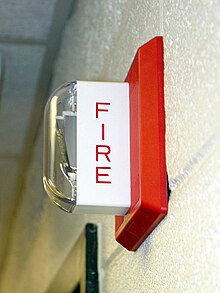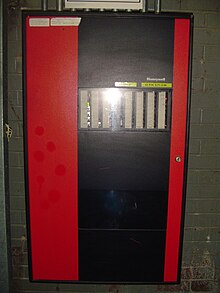Fire alarm system: Difference between revisions
m →Fundamental configuration: corrected V AC |
→External links: add link |
||
| Line 108: | Line 108: | ||
* [http://www.nfpa.org/aboutthecodes/AboutTheCodes.asp?DocNum=805 NFPA Standards] |
* [http://www.nfpa.org/aboutthecodes/AboutTheCodes.asp?DocNum=805 NFPA Standards] |
||
* [http://www.assured-ltd.co.uk/advice_article.php?id=20 Fire alarm weekly testing] |
* [http://www.assured-ltd.co.uk/advice_article.php?id=20 Fire alarm weekly testing] |
||
* [http://www.earlywarningsys.com/ Early Warning Systems |
|||
{{Fire protection}} |
{{Fire protection}} |
||
Revision as of 10:36, 31 October 2009
This article needs additional citations for verification. (January 2008) |

An automatic fire alarm system is designed to detect the unwanted presence of fire by monitoring environmental changes associated with combustion. In general, a fire alarm system is either classified as automatic, manually activated, or both. Automatic fire alarm systems can be used to notify people to evacuate in the event of a fire or other emergency, to summon emergency services, and to prepare the structure and associated systems to control the spread of fire and smoke.
Design
After the fire protection goals are established - usually by referencing the minimum levels of protection mandated by the appropriate model building code, insurance agencies, and other authorities - the fire alarm designer undertakes to detail specific components, arrangements, and interfaces necessary to accomplish these goals. Equipment specifically manufactured for these purposes are selected and standardized installation methods are anticipated during the design. In the United States, NFPA 72, The National Fire Alarm Code is an established and widely used installation standard.
Fundamental configuration

- Fire alarm control panel: This component, the hub of the system, monitors inputs and system integrity, control outputs and relays information.
- Primary Power supply: Commonly the non-switched 120 or 240 Volt Alternating Current source supplied from a commercial power utility. In non-residential applications, a branch circuit is dedicated to the fire alarm system and its constituents. "Dedicated branch circuits" should not be confused with "Individual branch circuits" which supply energy to a single appliance.
- Secondary (backup) Power supplies: This component, commonly consisting of sealed lead-acid storage batteries or other emergency sources including generators, is used to supply energy in the event of a primary power failure.
- Initiating Devices: This component acts as input to the fire alarm control unit and are either manually or automatically activated.
- Notification appliances: This component uses energy supplied from the fire alarm system or other stored energy source, to inform the proximate persons of the need to take action, usually to evacuate.
- Building Safety Interfaces: This interface allows the fire alarm system to control aspects of the built environment and to prepare the building for fire and to control the spread of smoke fumes and fire by influencing air movement, lighting, process control, human transport and exit.
Initiating devices
- Manually activated devices; Break glass stations, Buttons and manual pull station are constructed to be readily located (near the exits), identified, and operated.
- Automatically activated devices can take many forms intended to respond to any number of detectable physical changes associated with fire: convected thermal energy; heat detector, products of combustion; smoke detector, radiant energy; flame detector, combustion gasses; carbon monoxide detector and release of extinguishing agents; water-flow detector. The newest innovations can use cameras and computer algorithms to analyze the visible effects of fire and movement in applications inappropriate for or hostile to other detection methods.
Notification appliances

- Audible, visible, tactile, textual or even olfactory stimuli (odorizer).[1] to alert the occupants. Audible or visible signals are the most common and may utilize speakers to deliver live or pre-recorded instructions to the occupants. In the United States, fire alarm evacuation signals are required to use a standardized interrupted four count temporal pattern to avoid confusion with other signals using similar sounding appliances. Other methods include:
- Audible textual appliances, which are employed as part of a fire alarm system that includes Emergency Voice Alarm Communications (EVAC) capabilities. High reliability speakers are used to notify the occupants of the need for action in connection with a fire or other emergency. These speakers are employed in large facilities where general undirected evacuation is considered impracticable or undesirable. The signals from the speakers are used to direct the occupant's response. The system may be controlled from one or more locations within the building known as Fire Wardens Stations, or from a single location designated as the building Fire Command Center. Speakers are automatically activated by the fire alarm system in a fire event, and following a pre-alert tone, selected groups of speakers may transmit one or more prerecorded messages directing the occupants to safety. These messages may be repeated in one or more languages. Trained personnel activating and speaking into a dedicated microphone can suppress the replay of automated messages in order to initiate or relay real time voice instructions.[2]
Building safety interfaces

- Magnetic Smoke Door Holders: Wall or floor mounted solenoids or electromagnets controlled by a fire alarm system or detection component that magnetically secures spring-loaded self-closing smoke tight doors in the open position. Designed to de-magnetize to allow automatic closure of the door on command from the fire control or upon failure of the power source, interconnection or controlling element. Stored energy in the form of a spring or gravity can then close the door to restrict the passage of smoke from one space to another in an effort to maintain a tenable atmosphere on either side of the door during evacuation and fire fighting efforts.
- Duct Mounted Smoke Detection: Smoke detection mounted in such a manner as to sample the airflow through duct work and other plenums specifically fabricated for the transport of environmental air into conditioned spaces. Interconnection to the fan motor control circuits are intended to stop air movement, close dampers and generally prevent the recirculation of toxic smoke and fumes produced by fire into occupiable spaces.
UK fire alarm system categories
There are many types of fire alarm systems each suited to different building types and applications. A fire alarm system can vary dramatically in both price and complexity, from a single panel with a detector and sounder in a small commercial property to an addressable fire alarm system in a multi-occupancy building. Systems have to protect both buildings and occupants.
The categories of fire alarm systems are L if they are designed to protect life, P to protect buildings and M if they are manual systems.[3]
| M | Manual systems, e.g. hand bells, gongs, etc. These may be purely manual or manual electric, the latter may have call points and sounders. They rely on the occupants of the building discovering the fire and acting to warn others by operating the system. Such systems form the basic requirement for places of employment with no sleeping risk. |
|---|---|
| P1 | The system is installed throughout the building - the objective being to call the fire brigade as early as possible to ensure that any damage caused by fire is minimized. Small low risk areas can be excepted, such as toilets and cupboards less than 1m². |
| P2 | Detection should be provided in parts of the building where the risk of ignition is high and/or the contents are particularly valuable. Category 2 systems provide fire detection in specified parts of the building where there is either high risk or where business disruption must be minimised. |
| L1 | A category L1 system is designed for the protection of life and which has automatic detectors installed throughout all areas of the building (including roof spaces and voids) with the aim of providing the earliest possible warning. A category L1 system is likely to be appropriate for the majority of residential care premises. In practice, detectors should be placed in nearly all spaces and voids. With category 1 systems, the whole of a building is covered apart from minor exceptions. |
| L2 | A category L2 system designed for the protection of life and which has automatic detectors installed in escape routes, rooms adjoining escape routes and high hazard rooms. In a medium sized premises (sleeping no more than ten residents), a category L2 system is ideal. These fire alarm systems are identical to an L3 system but with additional detection in an area where there is a high chance of ignition, e.g., kitchen) or where the risk to people is particularly increased (e.g., sleeping risk). |
| L3 | This category is designed to give early warning to everyone. Detectors should be placed in all escape routes and all rooms that open onto escape routes. Category 3 systems provide more extensive cover than category 4. The objective is to warn the occupants of the building early enough to ensure that all are able to exit the building before escape routes become impassable. |
| L4 | Category 4 systems cover escape routes and circulation areas only. Therefore, detectors will be placed in escape routes, although this may not be suitable depending on the risk assessment or if the size and complexity of a building is increased. Detectors might be sited in other areas of the building, but the objective is to protect the escape route. |
| L5 | This is the "all other situations" category, e.g., computer rooms, which may be protected with an extinguishing system triggered by automatic detection. Category 5 systems are the "custom" category and relate to some special requirement that cannot be covered by any other category. |
See also
- Active fire protection
- Fire alarm control panel
- Fire alarm notification appliance
- Fire protection
- Fire Safety Equivalency System
- Multiple-alarm fire
References
- ^ NFPA 805 Performance-Based Standard for Fire Protection for Light Water Reactor Electric Generating Plants. Chapter 3 Fundamental Fire Protection Program and Design Elements: National Fire Protection Association. 2001.
{{cite book}}:|first=missing|last=(help); Check|first=value (help); Cite has empty unknown parameter:|coauthors=(help); Unknown parameter|month=ignored (help); Unknown parameter|standard=ignored (help)CS1 maint: location (link) - ^ Cote, Arthur E. (2000). Fire Protection Handbook eighteenth edition. National Fire Protection Association. pp. 5–7. ISBN 0-87765-377-1.
{{cite book}}: Cite has empty unknown parameter:|coauthors=(help); Unknown parameter|month=ignored (help) - ^ ""Fire Alarm System Categories"". Sdfirealarms.co.uk. Retrieved 2009-07-15.
External links
- Example Specification Section 13850 Fire Alarm Systems
- NFPA Standards
- Fire alarm weekly testing
- [http://www.earlywarningsys.com/ Early Warning Systems

